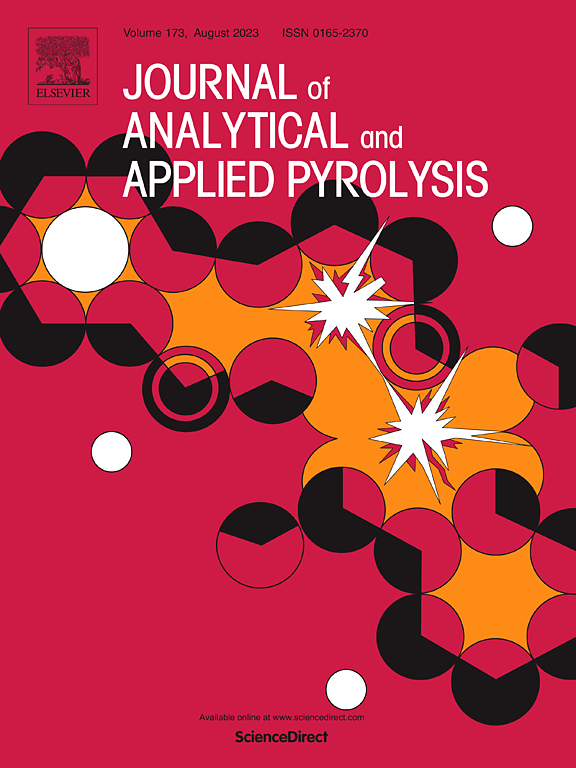Enhanced aromatics production via co-pyrolysis of biomass and plastic by Zn modified ZSM-5 catalysts
IF 5.8
2区 化学
Q1 CHEMISTRY, ANALYTICAL
引用次数: 0
Abstract
The co-pyrolysis of biomass and plastic with Zn/ZSM-5 catalysts were studied to improve the aromatic production. The Zn/ZSM-5 catalysts were synthesized by the impregnation method and characterized by BET, XRD, NH3-TPD and SEM methods. The effects of Si/Al ratios of ZSM-5, Zn loadings, catalytic temperatures, and mass ratios of feedstock-to-catalyst on the selectivity and composition of aromatics in the liquid products were investigated. It was found that under the optimal conditions of 5 % Zn loading, Si/Al ratio of ZSM-5 of 120, catalytic temperature of 500 ℃, and mass ratio of feedstock-to-catalyst of 1/2, the selectivity of monocyclic aromatics hydrocarbons (MAHs) can reach 86.02 %, and the selectivity of benzene, toluene, ethylbenzene, and xylene (BTEX) can reach 59.10 %. Furthermore, the stability experiments demonstrated that the 5 % Zn/ZSM-5 catalyst maintained the aromatic selectivity of MAHs above 85 % after 10 cycles. The mechanism of co-pyrolysis of biomass and plastic with Zn/ZSM-5 catalysts was also proposed, which indicates that the Zn/ZSM-5 catalyst promoted the formation of aromatics via Diels-Alder and dehydration reactions between furan derived from biomass pyrolysis and alkenes produced from plastic pyrolysis.
Zn改性ZSM-5催化剂促进生物质与塑料共热解生成芳烃
采用Zn/ZSM-5催化剂对生物质和塑料共热解进行了研究,提高了芳烃产量。采用浸渍法制备了Zn/ZSM-5催化剂,并用BET、XRD、NH3-TPD和SEM等方法对催化剂进行了表征。考察了ZSM-5的Si/Al比、Zn负载量、催化温度和原料-催化剂质量比对液体产物中芳烃的选择性和组成的影响。结果表明,在ZSM-5负载量为5 %、Si/Al比为120、催化温度为500℃、料催化剂质量比为1/2的最佳条件下,单环芳烃(MAHs)的选择性可达86.02 %,苯、甲苯、乙苯和二甲苯(BTEX)的选择性可达59.10 %。此外,稳定性实验表明,5 % Zn/ZSM-5催化剂经过10次循环后,对MAHs的芳香选择性保持在85 %以上。研究了Zn/ZSM-5催化剂催化生物质与塑料共热解的机理,表明Zn/ZSM-5催化剂促进了生物质热解生成的呋喃与塑料热解生成的烯烃通过diols - alder反应和脱水反应生成芳烃。
本文章由计算机程序翻译,如有差异,请以英文原文为准。
求助全文
约1分钟内获得全文
求助全文
来源期刊
CiteScore
9.10
自引率
11.70%
发文量
340
审稿时长
44 days
期刊介绍:
The Journal of Analytical and Applied Pyrolysis (JAAP) is devoted to the publication of papers dealing with innovative applications of pyrolysis processes, the characterization of products related to pyrolysis reactions, and investigations of reaction mechanism. To be considered by JAAP, a manuscript should present significant progress in these topics. The novelty must be satisfactorily argued in the cover letter. A manuscript with a cover letter to the editor not addressing the novelty is likely to be rejected without review.

 求助内容:
求助内容: 应助结果提醒方式:
应助结果提醒方式:


